Clinical Services
At West Michigan Dermatology, we combine the knowledge and compassion of our board-certified physicians with cutting edge technology to treat a wide range of skin conditions. From common skin conditions to skin cancer, our team will create a custom treatment plan designed specifically for you.
MOHS (Microscopically Oriented Histographic Surgery)
MOHS (Microscopically Oriented Histographic Surgery) is a highly specialized procedure used to completely remove skin cancers. Developed about 70 years ago by the late Dr. Frederic Mohs, it is used to treat all skin cancer types. Using a microscope, cancerous cells are traced to their roots with little guesswork, then surgically removed. MOHS surgery frequently results in success rates of 95 to 99%, even when other treatments have failed.
The entire surgical procedure typically requires two or three sessions, all performed in a single day. It is a precise surgical technique used to treat skin cancer. During Mohs surgery, thin layers of cancer-containing skin are progressively removed and examined until only cancer-free tissue remains. The goal of Mohs surgery is to remove as much of the skin cancer as possible, while doing minimal damage to surrounding healthy tissue. Mohs surgery is usually done on an outpatient basis using a local anesthetic.
Patients can Learn More About Mohs Surgery, including what the Mohs Procedure is, see the Mohs step-by-step process, and get answers to the most-asked questions about the procedure.
Blue Light Photodynamic Therapy
Blu-U is a unique, non-drug therapy that can be effective in treating moderate acne. When sebaceous glands just beneath the surface of the skin produce extra amounts of oil, this can clog the pores to the skin, trapping the oil. P. acnes bacteria thrive in these clogged pores, quickly leading to irritation of the skin and the formation of a “pimple.” Blu-U is a great alternative for those who are uncomfortable taking antiobiotics or are unhappy with their current antibiotic treatments.
Blu-U is light and gentle, using blue light to kill the P. acnes bacteria in the skin. During treatment, a patient needs only to sit close to the blue light for a short time – usually 16 minutes once or twice per week. The length of treatment varies depending on the severity of acne and will be discussed with you during your initial appointment.
Psoriasis
Psoriasis is a persistent skin disease that got its name from the Greek word for “itch”. The skin becomes inflamed, producing red, thickened areas with silvery scales, most often on the scalp, elbows, knees and lower back.
Treatment of psoriasis is based on the patient’s health, age, lifestyle, and the severity of the psoriasis. The goal is to reduce inflammation and to slow down rapid skin cell division. Moisturizing creams and lotions loosen scales and help control itching. Special diets have not been successful in treating psoriasis. Your dermatologist may prescribe medications to apply on the skin containing cortisone, cortisone-like compounds, synthetic Vitamin D, tar, or anthralin. These may be used in combination with natural sunlight or ultraviolet light. The most severe forms or psoriasis may require oral medications, with or without light treatment.
Sunlight exposure helps the majority of people with psoriasis but is must be used cautiously. Ultraviolet light therapy may be given in a dermatologist’s office, a psoriasis treatment center or a hospital. New therapies under investigation include “biologic agents” that attack the abnormal immune cells that lend to psoriasis. Your Dermatologist will decide which treatment fits you best.
Eczema
Eczema describes certain kinds of inflamed skin conditions including allergic contact dermatitis and nummular dermatitis. Eczema can be red, blistering, oozing, scaly, brownish, or thickened and usually itches. A special type is called atopic dermatitic or atopic eczema. Your dermatologist can prescribe external medications such as steroids and newer immune modifying creams. Internal medications such as antihistamines can help with the itch. Oral antibiotics may be prescribed if there is a secondary infection. For severe cases, your dermatologist may recommend ultraviolet light treatments.
Atopic eczema/dermatitis is a very common condition. With proper treatment, the disease can be controlled in the majority of people.
Skin Cancer Screening
Skin cancer is the most prevalent of all types of cancers. It is estimated that more than one million Americans develop skin cancer every year.
Fair skinned people who sunburn easily are at a particularly high risk for developing skin cancer. Other less important factors include repeated medical and industrial x-ray exposure, scarring from diseases or burns, occupational exposure to compounds such as coal tar and arsenic, and family history.
The best defense against skin cancer is sun avoidance. Overexposure to ultraviolet light (sunlight or tanning beds), especially if it results in sunburn and blistering, is the main cause of skin cancer. Protecting the skin from the sun’s ultraviolet rays is the best way to protect yourself from skin cancer.
Common Types of Skin Cancer:
Actinic Keratoses
Actinic Keratoses or solar keratoses are considered the earliest stage in the development of skin cancer. 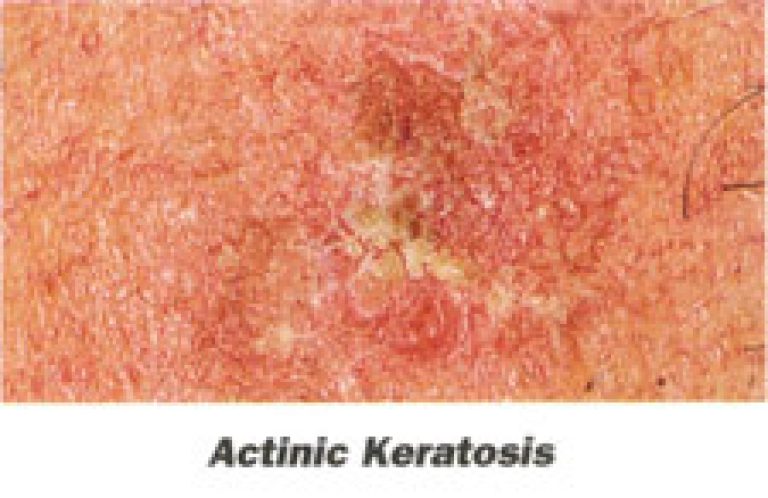 They are small, scaly spots most commonly found on the face, ears, neck, lower arms, and back of the hands in fair-skinned individuals who have had significant sun exposure Some actinic keratoses may progress to advanced stages which require more extensive treatment. Proper use of sunscreens can help prevent actinic keratoses even after extensive sun damage has already occurred.These lesions can be treated by cryotherapy (freezing), topical chemotherapy (applying a cream or lotion), chemical peeling, dermabrasion, laser surgery, and curettage.
They are small, scaly spots most commonly found on the face, ears, neck, lower arms, and back of the hands in fair-skinned individuals who have had significant sun exposure Some actinic keratoses may progress to advanced stages which require more extensive treatment. Proper use of sunscreens can help prevent actinic keratoses even after extensive sun damage has already occurred.These lesions can be treated by cryotherapy (freezing), topical chemotherapy (applying a cream or lotion), chemical peeling, dermabrasion, laser surgery, and curettage.
Basal Cell Carcinoma
Basal cell carcinoma is the most common type of skin cancer and appears frequently on the head, neck and 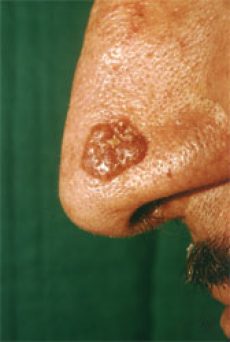 hands as a small, fleshy bump, nodule or red patch. Other parts of the body may be affected as well. Fair-skinned people are more prone to basal cell carcinomas. This type of cancer is rarely found in dark-skinned people. They do not spread quickly. It can take many months or years for one to grow to a diameter of one-half inch. Untreated, the cancer often will begin to bleed, crust over, heal and then repeat this process.
hands as a small, fleshy bump, nodule or red patch. Other parts of the body may be affected as well. Fair-skinned people are more prone to basal cell carcinomas. This type of cancer is rarely found in dark-skinned people. They do not spread quickly. It can take many months or years for one to grow to a diameter of one-half inch. Untreated, the cancer often will begin to bleed, crust over, heal and then repeat this process.
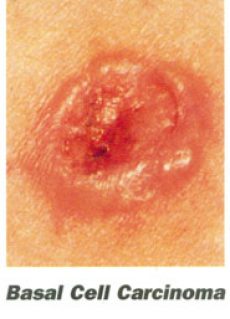 This type of skin cancer very seldom metastasizes (spreads to other parts of the body), but it can extend below the skin to the bone and nerves, causing considerable local damage.
This type of skin cancer very seldom metastasizes (spreads to other parts of the body), but it can extend below the skin to the bone and nerves, causing considerable local damage.
Treatment options include excision, topical chemotherapy, immune therapy, curettage and electrodessication and MOHS micrographic surgery.
Squamous Cell Carcinoma
Squamous cell carcinoma is the second most common skin cancer. It again is found mostly in fair-skinned 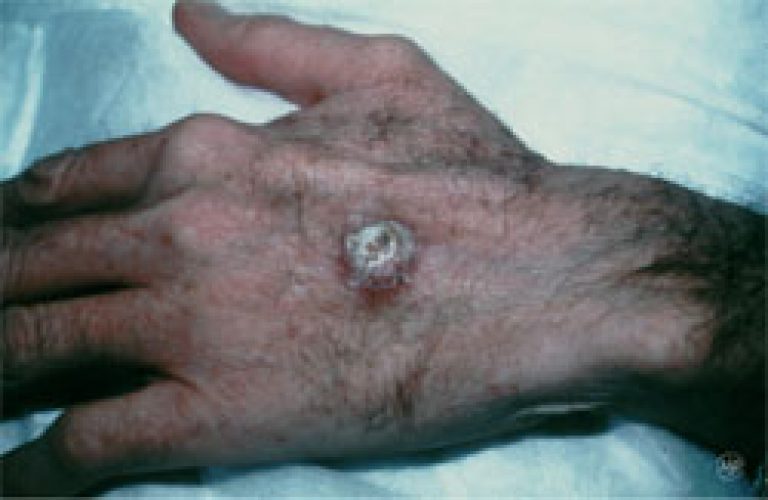 people, but very seldom in dark-skinned people. These are more commonly found on the rim of the ear, the face, lips, and mouth. This type of cancer may appears as a bump, or as a red, scaly patch. Squamous cell CA may turn into large masses and become invasive. Unlike basal cell carcinoma, this form of cancer can metastasize (spread to other parts of the body). Early diagnosis and treatment is essential. When found early and treated properly, the cure rate for both BCC and SCC is more than 95 percent.Treatment options include excision, topical chemotherapy, immune therapy, curettage and electrodessication, and MOHS micrographic surgery.
people, but very seldom in dark-skinned people. These are more commonly found on the rim of the ear, the face, lips, and mouth. This type of cancer may appears as a bump, or as a red, scaly patch. Squamous cell CA may turn into large masses and become invasive. Unlike basal cell carcinoma, this form of cancer can metastasize (spread to other parts of the body). Early diagnosis and treatment is essential. When found early and treated properly, the cure rate for both BCC and SCC is more than 95 percent.Treatment options include excision, topical chemotherapy, immune therapy, curettage and electrodessication, and MOHS micrographic surgery.
Malignant Melanoma

Malignant Melanoma is the most deadly of all skin cancers. It is estimated that 7,700 Americans will die from melanoma and that 46,000 Americans will develop this type of skin cancer. The death rate is declining because melanoma is usually curable when detected in its early stages and patients are seeking help sooner.Excessive sun exposure, especially sunburn is the most probable cause for melanoma. Light-skinned individuals are at particular risk, although dark skin is not a guarantee against melanoma. Heredity also plays a part since you have an increased chance of developing melanoma if a relative or close family member has had melanoma.
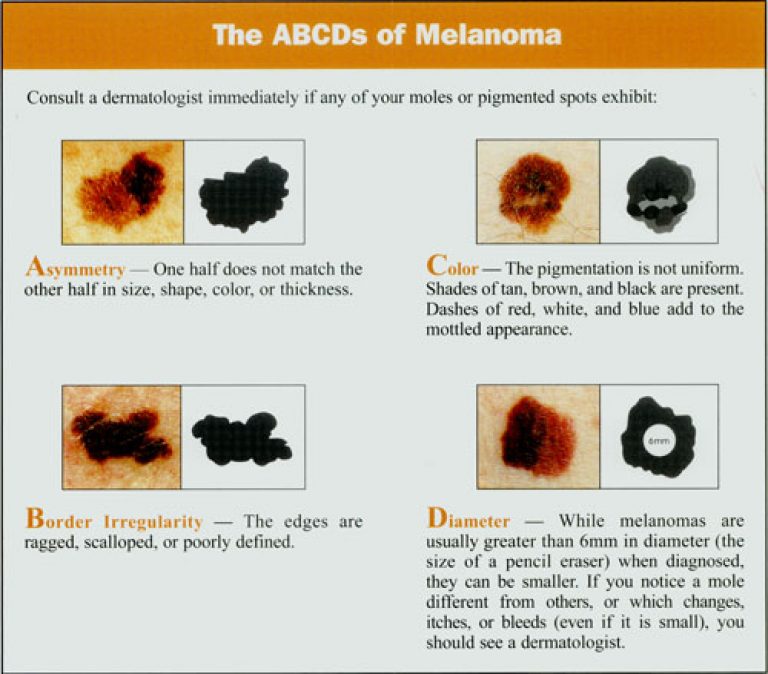
Periodic Self-Examination:
Early detection and removal offer the best chance for a cure. Periodic self-examinations aid in recognition of any new or developing lesion. Get familiar with your skin and your own pattern of moles, freckles, and “beauty marks.” Make sure to look at the entire body every month or two. Watch for changes in the number, size, shape, and color of pigmented areas. Consult your dermatologist at West Michigan Dermatology promptly if any changes are noticed. Individuals at high risk should be examined by a dermatologist on a regular basis.

